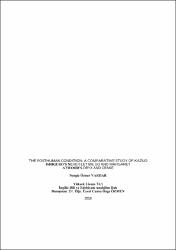| dc.contributor.author | Vardar, Nergiz Öznur | |
| dc.date.accessioned | 2020-01-02T11:39:32Z | |
| dc.date.available | 2020-01-02T11:39:32Z | |
| dc.date.issued | 2018 | |
| dc.identifier.uri | https://hdl.handle.net/20.500.11776/3355 | |
| dc.description.abstract | Recently, numerous scientific and technological advances have taken place and the humanist attitude that man is the measure of all things has been challenged by the flourishing manifestations of trans-/posthumanism. Therefore, what it means to be human has been questioned by various theoreticians like Cary Wolfe, N. Katherine Hayles, and Donna Haraway. In this regard, concepts like Self/Other, human/nonhuman, body/mind are analysed anew in the framework of trans- and posthumanism. As part of dystopian literature, Kazuo Ishiguro’s Never Let Me Go (2005) and Margaret Atwood’s Oryx and Crake (2003) not only indicate a posthuman condition but also illustrate the question of identity regarding the characters. Consequently, this study discloses breaking points which involve issues of authenticity, othering, as well as identity explorations of the individuals based on post-/transhumanist theories and significant issues of the contemporary age. Besides developing self-awareness to gain individual autonomy, the subjects’ ability to liberate themselves through the rejection of grand narratives is discussed with references to posthuman ethics in Never Let Me Go and Oryx and Crake in a comparative manner. | en_US |
| dc.description.abstract | Son yıllarda çeşitli bilimsel ve teknolojik gelişmeler meydana gelmiştir ve insan her şeyin ölçüsüdür fikrini savunan hümanist bakış açısına karşı trans-/posthümanist akımlar meydan okumaya başlamıştır. Üstelik insan olmanın anlamı, Cary Wolfe, N. Katherine Hayles, Donna Haraway gibi kuramcılar tarafından sorgulanmıştır. Bu noktada ben/öteki, insan/insan olmayan, beden/akıl kavramları trans-/posthümanizm çerçevesinde yeniden şekillenmiştir. Distopya türünün örneklerinden Kazuo Ishiguro’nun Beni Asla Bırakma (2005) ile Margaret Atwood’un Antilop ve Flurya (2003) romanları sadece insan sonrası durumu gözler önüne sermekle kalmaz, aynı zamanda karakterlerin kimlik sorununu da gösterir. Bu çalışma özgünlük, ötekileştirme, kimlik arayışı kavramlarını post-/transhümanist kuramlar ve dönemin öne çıkan meseleleri bağlamında değerlendirerek ana karakterlerin kırılma noktalarını inceler. Bireysel özerklik elde etmek için gerekli olan öz-farkındalığın kazanılmasıyla birlikte Beni Asla Bırakma ile Antilop ve Flurya romanlarındaki öznelerin üst anlatıları reddederek kendilerini özgürleştirmeyi başarıp başaramayacakları karşılaştırmalı olarak posthuman (insan sonrası) ahlak değerleriyle ilişkilendirilerek incelenir. | en_US |
| dc.language.iso | eng | en_US |
| dc.publisher | Namık Kemal Üniversitesi | en_US |
| dc.rights | info:eu-repo/semantics/openAccess | en_US |
| dc.subject | Kazuo Ishiguro | en_US |
| dc.subject | Margaret Atwood | en_US |
| dc.subject | metanarrative | en_US |
| dc.subject | othering | en_US |
| dc.subject | posthuman subject | en_US |
| dc.subject | posthumanism | en_US |
| dc.subject | self-awareness | en_US |
| dc.subject | transhumanism | en_US |
| dc.subject | üst anlatı | en_US |
| dc.subject | ötekileştirme | en_US |
| dc.subject | posthuman özne | en_US |
| dc.subject | posthümanizm | en_US |
| dc.subject | öz-farkındalık | en_US |
| dc.subject | transhümanizm | en_US |
| dc.title | The posthuman condition: a comperative study of kazuo ishiguro’ s never let me go and margaret atwood’ s oryx and crake | en_US |
| dc.type | masterThesis | en_US |
| dc.department | Enstitüler, Sosyal Bilimler Enstitüsü, İngiliz Dili ve Edebiyatı Ana Bilim Dalı | en_US |
| dc.relation.publicationcategory | Tez | en_US |



















